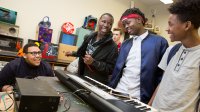Using Genius Hour Projects to Help Students Find Meaning
Teachers who guide middle and high school students to work on passion projects see several benefits, including greater learning gains.
Your content has been saved!
Go to My Saved Content.Genius projects are back, and they’re better than ever. Students are searching for meaning, and genius projects are the perfect vehicle to show them how much they matter.
The term “genius projects” stems from the 20 percent time Google encourages their employees to take learning things that are of interest to them.
I found this past semester that the genius projects my students created rose to new heights of achievement. Last year, I saw more interest, more time commitment, and better results from my class than in the last 10. From the three boys who built the whole school in Minecraft to the two girls who recorded their first album single, genius projects created an electric environment in my classroom this past December.
Why Genius Projects? Why Now?
With the current mental health crisis affecting our children and the need to invest in the mental health and well-being of our students in a broad, comprehensive way, sensitively run genius projects are one way to help kids find the meaning they need.
Whether they like soccer or science, video games or volleyball, cooking or cutting up and telling jokes, anyone who works with students knows that their interests are as diverse as the clothes they wear on the weekend.
Unique personalization is nothing new. The great educator Booker T. Washington warned against one-size-fits-all teaching. In his autobiography, Up From Slavery, he wrote, “The temptation often is to run each individual through a certain educational mold regardless of the subject or the end to be accomplished.”
Personalization has always been a hallmark of successful genius projects. The results I’ve noticed reflect the studies that show that people who have created meaning in their lives are happier and more satisfied. Genius projects are in the unique category of projects whose very presence can change a life, unleash a talent upon the world, and change history.
4 Steps to Creating Genius Projects That Matter
Step 1: The verbal pitch. From the moment we start genius projects, we use the empowering language of leadership. The question is not “What does my teacher want me to do to get good grades?” but “What do I want to learn?” and “How can I solve an authentic problem?”
Students pitch their ideas verbally, and I listen for wonder and excitement to help guide them. I feel like Robert Frost, who said, “I’m not a teacher, but an awakener.” Negative environments are idea killers. A sneer, chuckle, or wrong word at the wrong time can kill good ideas, so I have to be fully engaged with students in conversation.
During her verbal pitch, one student said, “I wonder if I could record a song?” Her friend piped up, “I wonder if I could produce it?”
My answer? “Yes! Here’s what you’ll need to learn and do to make that happen; let’s do it.”
Another student said, “I made a Rube Goldberg machine before; I’d like to do that again.” Since I want students to level up, we made a device that was much more extensive, as they decided to light the Christmas tree in front of a high school assembly.
Step 2: The written pitch and project plan. Next, students write a pitch using a template to define their real-world problem. Additionally, they identify the software and expertise they will need to complete the project.
We use the traffic light metaphor throughout the pitch process, much like Hollywood producers. The green light means all is good, and they may go into “production.”
The yellow light means that some things need to change to gain approval. For example, students created a parent app that was too much to do in nine days. So, they redefined the scope of work to earn their green light.
While the red light means stop, I have never had to red-light a project. For example, one student wanted to build a tennis racket stringer. He learned that it would be time-consuming and expensive and asked to join the Minecraft team instead. Students give themselves the red light, not me.
Step 3: Project implementation. As students have goal clarity, engagement skyrockets. Psychologist Kari Eddington found that the areas of the brain that produce dopamine and the “urge to do something” are highly active when someone feels very motivated and action-oriented about a goal.
My primary job, at this point, is that of facilitator. Here are three examples: I found a room for music recording, got fast administrative approval for the Christmas tree lighting machine, and helped one student adjust the length of the book she was writing. I help every student figure out the next action step and constantly share new ideas for leveling up. I keep a list on the board where students request meetings, inquire about a training class, or ask for help.
Students have three self-selected checkpoints during implementation where they reflect and take photographs and videos.
Step 4: Audience presentation and reflection. Finally, students share their creations, perform, or present their learning to the class.
This past December, we celebrated. Not only did we celebrate the holidays, but we celebrated a new single, a special-effects triumph in Adobe After Effects, some fun videos, a new app, and more.
Most of all, my students began to collaborate, communicate, and, best of all, laugh. I have no doubt that some lives were changed this past December, including mine. Nowadays, genius projects teach us the most valuable thing we could ever give students—knowledge of their own unique gifts.
I’m not here to mark papers, I’m here to make a mark on students’ lives. May we never run so fast to do all the “things” that we miss the things that really make a difference. Genius projects are one of the difference makers, especially now.
